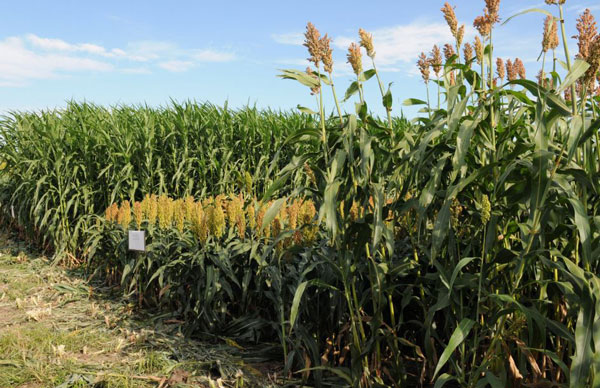In 2020, summer annual forage variety trials were conducted across Kansas near Garden City, Hays, and Scandia. All sites evaluated hay and silage entries. Companies were able to enter varieties into any possible combinations of research sites, so not all sites had all varieties. Across the sites, a total of 98 hay varieties, 78 sorghum silage varieties, and 11 dual-purpose sorghum silage varieties were evaluated (Table 1). The full 2020 Kansas Forage Report can be accessed online at https://newprairiepress.org/kaesrr/vol7/iss6/.

Introduction
In Kansas, there were 2,400,000 acres of hay and haylage harvested with an average yield of 2.24 dry matter tons per acre. Of this total, 650,000 acres were alfalfa with an average yield of 3.72 dry matter tons per acre, and 1,770,000 acres were crops other than alfalfa with an average yield of 1.69 dry matter tons/a. Kansas ranked 6th in the U.S. for hay and haylage production. This largely supports the state dairy (ranked 19th in the U.S. and valued at $483,000,000) and cattle (feedlot, background, and cow/calf) industries (ranked second in the U.S. and valued at $10,200,000,000). Dairy and beef cattle represented 58% of the total agricultural product of Kansas. Hay and grain commodities that support these two industries are critical for the state.
Study Objectives
The objectives of the Kansas Summer Annual Forage Hay and Silage Variety Trial are to evaluate the performance of released and experimental varieties, determine where these varieties are best adapted, and increase the visibility of summer annual forages in Kansas. Breeders, marketers, and producers use data collected from the trials to make informed variety selections. The Summer Annual Forage Trial is planted at locations across Kansas based on the interest of those entering varieties into the test.
This work was funded in part by the Kansas Agricultural Experiment Station and seed suppliers. Sincere appreciation is expressed to all participating researchers and seed suppliers who have a vested interest in expanding and promoting annual forage production in the U.S.
Inestimable differences in soil type, weather, and environmental conditions play a part in increasing experimental error, therefore one should use more than one location and one year of data to make an informed variety selection decision. Please refer to previous years’ forage reports to see how a variety performed across years.

John Holman, Cropping Systems Agronomist, Southwest Research-Extension Center
jholman@ksu.edu
Augustine Obour, Agricultural Research Center – Hays
aobour@ksu.edu
Tags: silage hay fall forage summer annual forage variety trials